Annual Report – Summer 2021

Message from the Manager
In preparation for writing the manager’s message for this edition of the Oystercatcher, I took a look back at last year’s annual report. A year ago, we were seeing the number of new COVID cases grow exponentially in Florida and the Reserve staff was settling into a new normal. Many staff were working from home and only coming into the office for field work and the necessary maintenance of the facilities. Last summer I spoke about resilience and adaptability. Those were certainly the themes of the past year, along with flexibility and patience. The staff were able to adapt to ever changing conditions, complete all of their tasks, and ultimately be successful despite everything that was going on. Their accomplishments are astounding considering all of the challenges, and I am truly proud of their work.
During the last year, the Reserve has made big strides in revising the management plan. We submitted a draft for review this past winter and are currently working through edits before it goes before agency and public review. The management plan is an important tool for directing our work over the next five years. We are hoping to have it finalized and approved by early 2022.
Over the last eight months, the Reserve has been preparing for our NOAA evaluation. Approximately every five years (in our case, seven), each Reserve is evaluated to ensure compliance with federal regulations and the terms and conditions of our annual grant award. As part of this evaluation, the Reserve prepared an informational document summarizing accomplishments over the last seven years. In early August, the evaluation was held virtually with the Reserve staff and staff from NOAA. Various stakeholders were invited to provide their perspectives on the operation of the Reserve, provide insights on challenges, and identify needs. This information is incredibly valuable to the administration of the Reserve and will feed directly into the draft management plan.
Finally, I’d like to highlight a new partnership with the Florida State University Coastal and Marine Lab. The Reserve has entered into a contract with the University to support full time positions at the Research Reserve. With this agreement, six positions will be moved from temporary status to full time, providing additional benefits to the staff. We hope that this new arrangement will help with the retention of staff in these valuable positions. The agreement also strengthens the long-standing partnership between the Reserve and the FSUCML, which will bolster each of our program areas from research to education and outreach. I’m excited to explore this new opportunity and see how we grow!
Stewardship Program
By Caitlin Snyder, Stewardship Coordinator
The goal of Stewardship is to protect, maintain, and restore the natural resources on Reserve-managed lands from factors which degrade natural communities and affect adjacent water quality. The team focuses on a diversity of projects, including habitat management and mapping, listed species monitoring, invasive species control, land acquisition, cultural resource protection, outreach programming, restoration, and facilitation of public use and access. This sector works closely with the other sectors to promote and practice informed stewardship of upland and aquatic resources to conserve the area’s natural biodiversity through applied research and education. The team also relies heavily on partnerships with other local land managers and regional agency groups to accomplish common goals of conservation across the panhandle landscape.
Resource Management
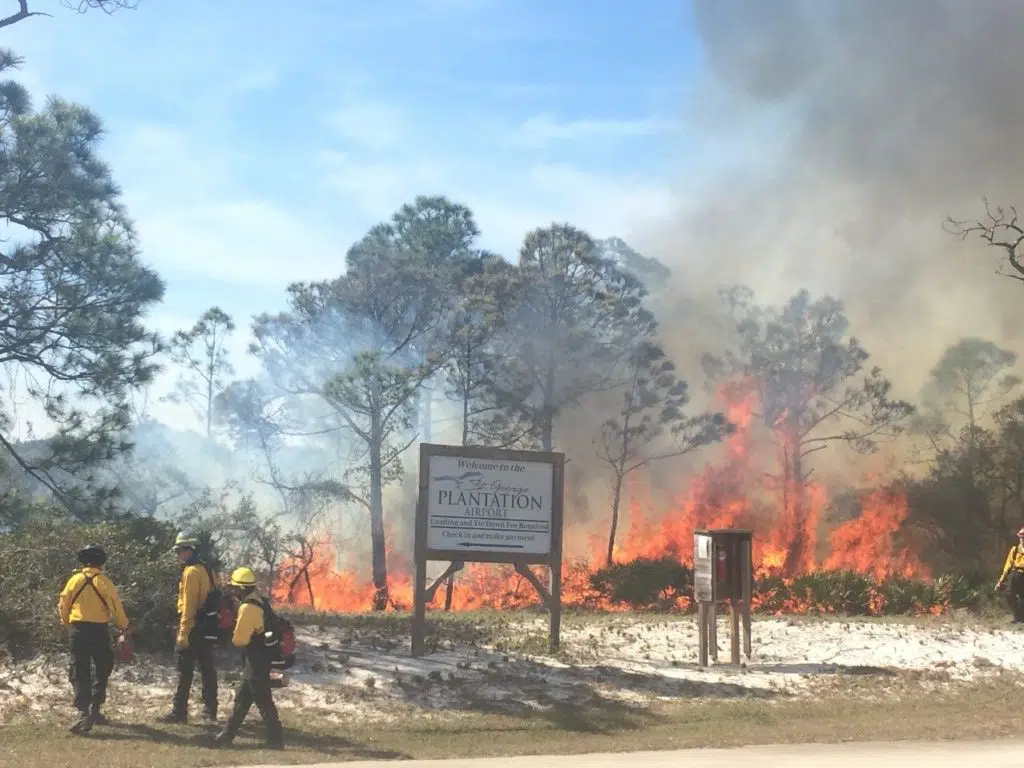
Stewardship continued to work towards the reintroduction of prescribed fire, where possible, and mitigation for wildfire on Reserve-managed lands. Staff participated in burning both Reserve and St. Joseph Bay State Buffer Preserve lands as part of a DEP fire team under the leadership of Dylan Shoemaker. At the Reserve, the unique 50-acre Nick’s Hole parcel on St. George Island was burned in February with assistance from multiple partners. Firebreaks along property lines were maintained and hazard trees were felled at other wildland-urban interfaces such as Unit 4 and in Eastpoint.
Staff continued to monitor listed species within the Reserve. Coordination Audubon Florida and FWC was critical in order to monitor shorebirds as well as nesting sea turtles. Staff helped with sign posting at nesting sites (including the SGI Causeway Critical Wildlife Area) and other annual surveys. Staff also collaborated with USGS researchers to conduct gopher tortoise and box turtle population surveys (Little St. George) and survey estuarine habitats for diamondback terrapins.
Both winter and summer photopoint monitoring was completed across all stations by staff. In addition, two citizen science photo stations (https://www.chronolog.io/) were installed at frequently visited sites. GIS staff are in the process of updating the Habitat Mapping and Change Plan for the Reserve, which was originally completed in 2014, as well as an updated version of the Roadmap to Recreation (2016).
The team completed a seventh year of NERR emergent marsh vegetation monitoring at two sites: Little St. Marks River and Pilot’s Cove. Starting in 2022, one more emergent vegetation site will be added (Unit 4) as well as NERR mangrove monitoring plots at Unit 4 and Pilot’s Cove. The Stewardship Coordinator built upon the baseline mangrove mapping effort that occurred from 2016-2019 by publishing a peer-reviewed journal article, featured in the journal Estuaries and Coasts. Annual mangrove monitoring at 20 local transects was conducted as part of a regional team investigating mangrove establishment and recruitment along the Northern Gulf of Mexico. Collaboration with external mangrove research is also on-going.
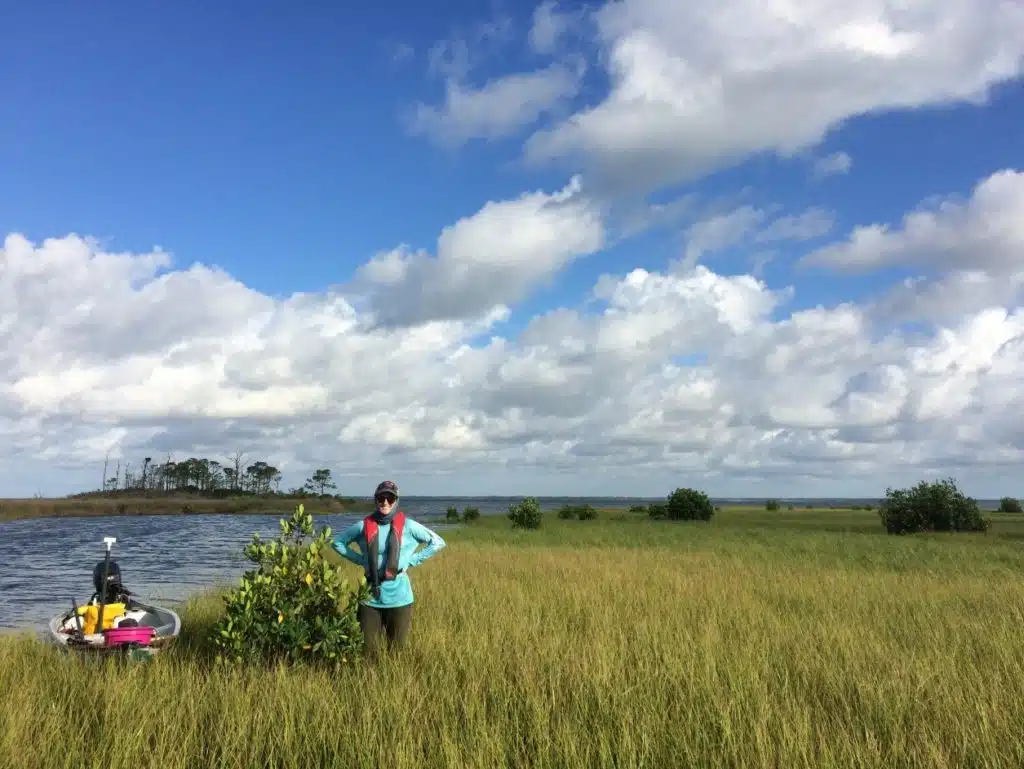
In annual invasives management, staff tackled historically occurring infestations of popcorn tree (Chinese tallow), rattlebox, camphor tree, as well as new occurrences of coral ardisia, wisteria, and Peruvian primrose willow. Staff utilized methods of both mechanical and chemical control where appropriate and collected spatial data on all occurrences and treatments. Staff communicated with partners on Early Detection, Rapid Response (EDRR) of emerging species including beach vitex and Brazilian peppertree.
Public Use and Access
After reopening, the Nature Center boardwalks, Millender Park and many satellite parcels in the Reserve continued to be popular to visit within COVID19 guidelines. Over ten miles of primitive trail, nine public access sites, and eleven kiosks were maintained by stewardship with the goal of promoting low-impact recreation and access to public lands and waters. Interpretational signage, kiosks and brochures continued to provide information at field sites to both locals and visitors. The team also continued to partner with the Conservation Corp to improve sections of the Scipio Creek Boardwalk in Apalachicola.
For cultural and historical resources, staff conducted annual surveys to monitor sites within the Reserve’s boundaries, including shell middens and the historic Marshall House complex. Staff continued to maintain both the Government and Marshall docks on Little St. George Island and remove debris from the island’s shorelines.
Restoration
Reserve staff coordinated with the Conservation Corps of the Forgotten Coast, Northwest Florida Water Management District, and the Reserve’s Coastal Training Program Coordinator in the development of the Oyster Corps pilot project. This grant funded project developed an oyster shell recycling program in the county and provided materials for the native marsh plant nursery. The Reserve continued to coordinate with the Corps to expand the co-managed nursery to Reserve-managed lands. The native, marsh plants grown in the nursery will be used for local living shoreline restoration projects.
The Reserve continues to coordinate with the Apalachee Regional Planning Council (ARPC) and WSP to discuss data, design, permitting, and next steps for the Franklin-98 project. This project seeks to enhance the habitat along the 12-mile section of Highway 98, between Eastpoint and Carrabelle, with a “living shoreline.” The goal of the project is to improve ecological productivity and to reduce chronic erosion that is threatening the roadway and other coastal infrastructure.
Reserve staff serve as the Chair of the Panhandle Estuarine Restoration Team (PERT) Steering Committee. This year, PERT hosted their third annual membership meeting virtually to provide participants with an opportunity to network with restoration professionals in the panhandle and to share information about projects, lessons-learned, resources, funding and technologies.
Stewardship Strong
Summer 2021 brings about additional change in staffing. Peyton Aubin, who joined the team after being a 2019 sea turtle intern, rejoined his family in Louisiana in April. Lexy Preheim quickly replaced him as lead sea turtle and shorebird field coordinator for the Reserve just in time for summer. Tucker Heptinstall, stewardship’s summer intern supported by FOR, was critical (and energetic) for sea turtle nest monitoring, invasive species surveys, and photopoint monitoring. Kelly Joyner, who came onboard spring 2020 as the GIS/Stewardship Specialist, took a job with FWC in Panama City in July, but Stewardship plans to be at full team capacity moving into fall.
Stewardship was a strong, productive team throughout the pandemic, despite challenges. Staff actively participated in the Apalachicola Regional Stewardship Alliance (ARSA) and other regional groups virtually throughout the year, focusing on coordinating land management issues, land acquisition proposals, and restoration, prescribed fire assistance, and invasive species assistance.
Research Program
By Jason Garwood, Research Coordinator
The resilience and ability of our staff to remain productive in challenging conditions seems to be tested on a yearly basis. Despite the presence of a pandemic and the constraints of teleworking and social distancing that came with it, Reserve staff still found novel methods for getting work done both safely and effectively. One of the biggest examples to highlight this fact was ANERR’s first Annual Research Symposium. Reserve staff from all sectors collaborated remotely to host an online scientific meeting highlighting research at the Reserve. We hosted a total of thirty-six speakers on a wide range of topics including the results of three internal Reserve projects from Research and Stewardship. The symposium afforded us the opportunity to host two keynote speakers, Dr. Chris Kinkade, the national NERR Research Coordinator, and Adam Blalock, the Florida DEP Deputy Secretary of Ecosystems Restoration. In total, we had 155 participants between the two days. Not only did the symposium receive positive feedback from those who participated, but it has also expanded collaboration between the Reserve and outside researchers. This symposium could not have happened without the hard work of all Reserve staff including management, CTP and Education staff who helped develop and run the event.
Restoration and resiliency of SWMP towers
Research is pleased to announce that we are finally near completion of our water quality stations post Hurricane Michael. We have restored our telemetry systems and our real-time data for East Bay are once again available online (https://cdmo.baruch.sc.edu/). One of the final tasks we have scheduled for this summer will be to complete the installation of the FlowThru grating on each of the towers. We’re hoping that this decking material will to allow us to safely maintain these towers while at the same time render our stations much more resilient to storms by removing the buoyancy of the wooden bases that were implemented on our previous stations.
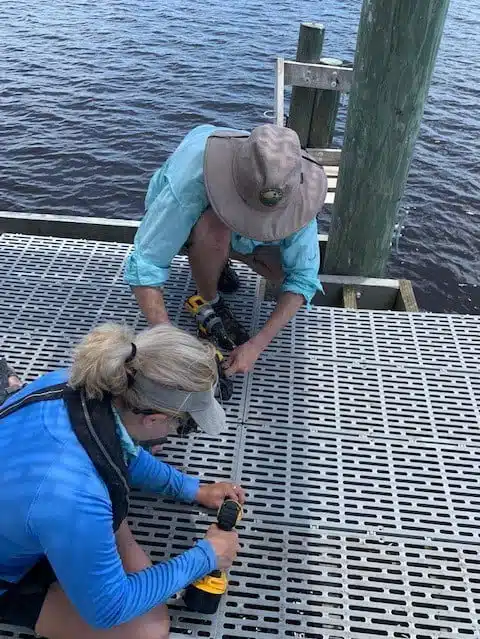
NERRs Science Collaborative Grant
The Research Coordinator collaborated with several other NERRs to successfully fund a NERRs Science Collaborative grant titled “Detecting Impacts from Climate Change across Multiple Scales: A National Synthesis of Tidal Marshes.” The overall goal of this project is to conduct a detailed, national-scaled synthesis of tidal marsh response to climate change. More specifically, this project will enable NERRs to quantify changes in marsh vegetation communities in response to changes to sea-level. Our main objectives of this study are to provide:
- Insight on how climate change is affecting marshes nationwide
- NERRs-specific templates and automated tools for analyzing and visualizing our data
- Transferable utility to other organizations with marsh monitoring datasets
- A framework for guiding and facilitating additional national-level research
- Produce education and science translation products to support management and policy.
To reach these goals and objectives we plan to use a collaborative approach that engages our primary end-users throughout the project through utilization of multiple distinct project teams led by project leaders. This project has been highly anticipated by the NERRs RC community and we recently began our project kick-off in spring 2021.
Net Ecosystem Metabolism, and Ocean Acidification
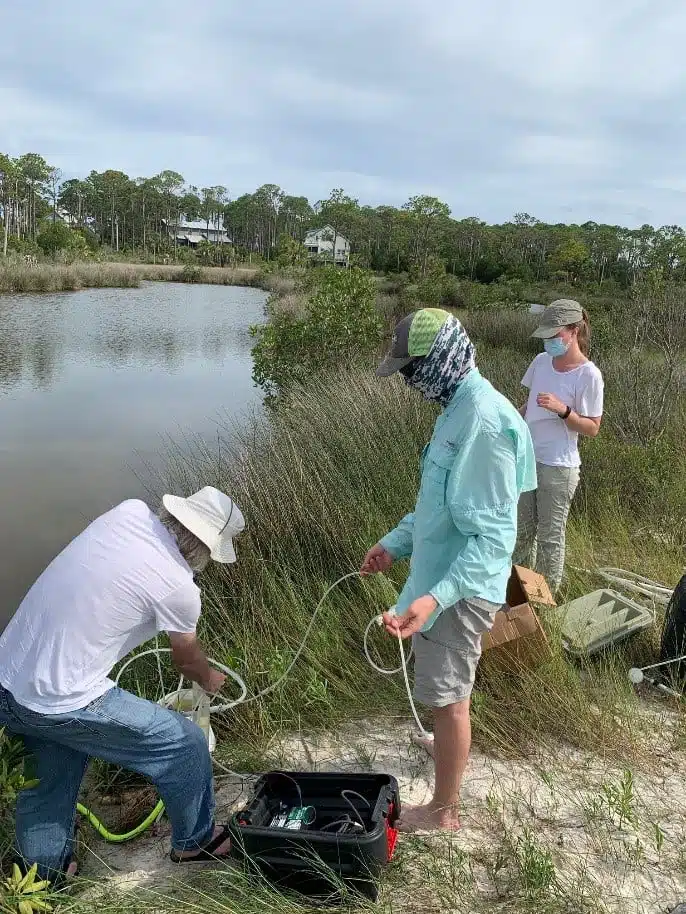
The Reserve has been collecting data on bay water quality since the early 1990s. One of the many uses for these long-term data is to be able to calculate the metabolic health of the bay by estimating rates of gas exchange, mainly CO2, at the water-air interface. In the past Research staff have only been able to quantify bay metabolism by performing calculations using our temperature, salinity, and dissolved oxygen data from our 15-minute datasets. During spring 2021 Research staff collaborated with researchers from Columbia University to conduct direct measurements of gas exchange at various locations around the system. These direct measurements will allow us to compare our direct measurements to our calculated rates, which will provide us with better insight on the metabolic function of our estuary. These processes are important because they directly relate to lower food web function of our estuary, which support resources such as our oyster, crab, shrimp and finfish fisheries. The data collected from this effort will also allow us to quantify the potential for documenting ocean acidification, a global phenomenon which has major implications for estuaries, especially those organisms who possess calcified shells that may be vulnerable to dissolution in water bodies that become too acidic.
New surface elevation table installation
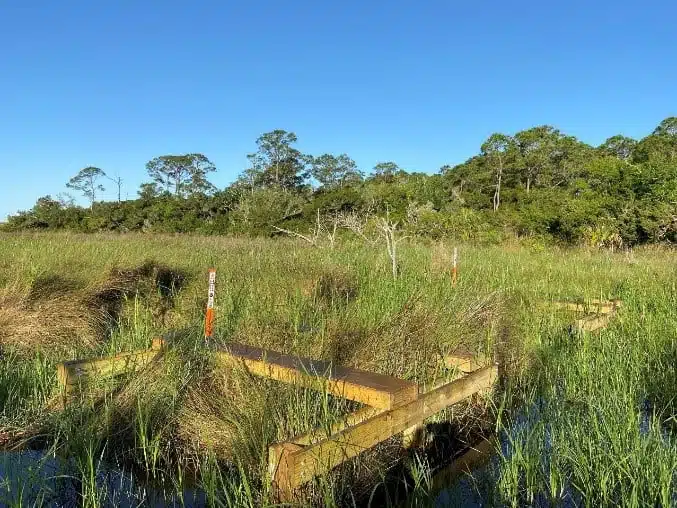
In spring of 2021 Research staff collaborated with the Florida DEP Survey and Mapping team to install four new surface elevation tables (SETs), bringing our SET inventory up to a total of 24. These SETs are used to document and quantify whether or not our marshes are able to keep up with the local increase in sea level from changes in our global climate. The new SETs were installed in the marsh located on the bay side of the building behind our living shoreline. Not only will these newly established sites be used for continued monitoring of the effects of sea level rise, but these particular SETs, being right next to the building, have the potential to be used as part of our Education program, specifically for the Teachers on the Estuary as an on-hands example of how scientists quantify and monitor the effects climate change.
Upcoming 2021:
Decadal Lower River Marsh Hardwood Survey – Prior to the pandemic we had been planning to collaborate with Auburn University to complete a 10-year census of the status of the lower river marsh hardwoods. To accomplish this task, we have also purchased four temperature, salinity, and oxygen sensors to measure marsh pore water characteristics. These sensors will be installed in the marsh soils to track how water availability and water quality may influence the abundance, growth, and distribution of hardwoods in the lower river marshes. The project launched and is currently running as of July 2021.
NERRs Margaret A. Davidson Fellowship 2022 – It seems like yesterday that we went through the process of selecting our first Margaret A. Davidson Fellow, Kira Allen. Kira has been very successful with her project working with the Reserve on our 20-year fish and invert dataset. She is ahead of task in her graduate program and is on schedule to complete her program in 2022. Currently, we’re beginning the process of selecting the 2022 Davidson Fellow. The call for applications began in July 2021. All applications will be due by December 2021 and by spring 2022 we will have selected our next student. For more information about the NERRs Margaret A. Davidson Fellowship contact Jason Garwood, Research Coordinator (jason.garwood@floridadep.gov).
Education
By Jeff Dutrow, Education Coordinator
Due to the Covid-19 pandemic the Reserves Nature Center was closed for almost 90% of the Annual Reporting period. Significant efforts were made to maintain mission objectives in education for the general public and student programming to foster stewardship of the Apalachicola Estuary.
The Nature Center was reopened on May 11, 2021. Subsequently 5,958 people visited the Reserve Nature Center or took part in educational programs provided by Reserve staff over the remaining portion of the reporting period. The majority of this participation was from walk-in visitors which accounted for 5,276 visitors. Staff-facilitated educational programs for students accounted for the additional 682 participants.
Group Programs
The primary venue for group programs and activities is the Reserve’s center in Eastpoint, which includes our outdoor classroom and regular sessions at Cat Point behind the Reserve’s Nature Center. These facilities were closed for the majority of the fiscal year and as such unavailable for programming. Estuaries Day, an important community yearly event and an essential component of education programming at ANERR, was held with significant modifications. To address the limitations of site closure, Estuaries Day was redesigned to expand the scope of a traditional one day event to a full week of virtual activities. These activities included a virtual presentation celebrating 20 years of Estuaries Day at ANERR. Virtual activities also included videos on Research and Monitoring on Apalachicola Bay and a daily upload of the Creature Feature Video Series “Creature Feature” highlighting Mollusks, Crustaceans, Echinoderms, Creature Sponges and Tunicates.
The majority of the activities were online with one significant exception being an in-person BioBlitz Outreach Event to close out the week. This event, a first at ANERR, was facilitated at nearby St George Island State Park. Participants met staff at multiple field stations to collect and identify species for a cumulative species total using the iNaturalist Program. Participants were scheduled at timed intervals to minimize interactions, with masks worn at all times.
School Programs
Formal Education programming was severely affected by the COVID -19 pandemic. The necessary protocols largely precluded delivery of in-person education programming for the majority of the reporting period.
A significant effort to adapt and meet program needs was pursued through the development of new virtual resources. K-12 programing was conducted both virtually and in field with modifications to the program design. The key accommodation to allow for in-person programming was to reduce class sizes by offering multiple group sessions over additional days. This approach allowed for a reduced ratio of students to staff and minimized group density. Activity components normally held indoors were staged outdoors. All staff and students maintained the use of masks and surfaces were disinfected between group rotations. The development of safety protocols was completed with the local school district and DEP. An unanticipated outcome from this process has been the school’s recognition of the benefits of the reduced ratio of students to staff on the quality of the student experience and overall learning. Going forward the expectation is that we will continue to maintain this approach whenever possible.
Virtual resources were developed for many of the programs that could not be conducted in-person. These include a full-length presentation of the popular Turtle Talk as well as the following; A Trip Down the Watershed Walk, Seining the Bay, Monarch Tagging, Bay Discovery Room and a four-part series: “Creature Feature” highlighting Mollusks, Crustaceans, Echinoderms, Creature Sponges and Tunicates. Additionally, each of the in-field program conducted with K-12 classes were videotaped for further development into virtual class programming and to serve as staff tutorials. These videos, completed during this grant period, captured the 3rd Grade Oyster Discovery Dig and Marsh Seining, the 7th Grade Living Shoreline Food Web Assessment and Monarch Tagging, the 5th Grade Spartina Biology and Living Shoreline Planting, the 1st Grade Introduction to Estuaries and the pre-K House for Hermit Crab Interactive Story.
A valuable outcome from the necessary adjustment to programming has been the collaboration across Reserve sections to create virtual resources. Lessons learned from this work will significantly benefit the Reserve going forward.
TOTE – Teacher’s on the Estuary
TOTE, a yearly professional development program for teacher’s, was rescheduled for the Fall of 2021 due to Covid-19. The shift in the timeline provided an opportunity to redesign the workshop to specifically target teachers that regularly bring their students to ANERR Education programs. This redesign, one of many attempts to recruit and accommodate local teachers in TOTE, is a new and unique plan that is allowable due to recent changes to TOTE NOAA requirements.
The initial preparation for this workshop occurred in the Spring of 2021. While facilitating student programs extensive video work was completed to build a library of representative content for each student program. These videos will be edited to assemble tutorial videos for teachers to review as a resource for developing lessons. The goal will be for each teacher to develop a specific activity or lesson to align with the content associated with the corresponding ANERR program in which their students participate. Further, given the scaffolded design of ANERR Education programming that sees every student in the District every year at years pre-K, 1, 3, 5 and 7, it is anticipated that teachers in the interim years (K, 2,4,6,8) will also be candidates for participation in TOTE and greatly expand the pool of participating teachers.
Coastal Training Program
By Anita Grove, CTP Coordinator
The Reserve’s Coastal Training Program (CTP) section is comprised of Coastal Training Program Coordinator Anita Grove, and the Coastal Training Program Specialist Josh Eaton. Together they bring resources, technical assistance, and trainings to decision makers, appointed leaders, and their staff to assist them in implementing sound coastal management policies to protect Apalachicola Bay and River resources vital to health of our estuary, our economy, and our quality of life. The Coastal Training Program Coordinator regularly attends meetings of the Franklin County Commission, Apalachicola City Commission meetings, and monthly Apalachicola and Franklin County Planning and Zoning meetings to stay up to date on area needs and issues and to strengthen partnerships. We also consult documents such as the Northwest Florida Water Management District Surface Water Improvement Plan and the Apalachicola Area of Critical State Concern Workplan to help assess needs in the watershed.
CTP fosters working relationships with local businesses and professionals, including city and county planners, land managers, real estate professionals, the tourism industry, seafood dealers and harvesters, landscapers, developers/builders, marine contractors, and recreational fishing and tour guides to help increase stewardship of local resources and increase the resilience in our coastal communities. We provide science-based trainings and information on land management issues, resiliency, climate change, and adaptation.
Our Stewardship Series offers courses to residents and visitors to create better understanding of coastal ecosystems and build a strong stewardship ethic in the community. Courses are designed to expand knowledge and result in increased preservation of habitats, in addition to natural and cultural resources.
Covid-19 restrictions limited our ability to hold in person workshops from March 2020-May 2021, so we transitioned to virtual trainings. Partnering with NOAA’s Office for Coastal Management we hosted nine formal trainings for 208 people which equated to 38 hours of training. Courses included Fostering Behavior Change for Coastal Managers, Tools and Techniques for Facilitating Virtual Meetings, Social Science Basics for Coastal Communities and Planning Effective Projects for Coastal Communities.
We conducted a socially distance workshop for the Apalachicola Planning and Zoning Committee in October for 28 people. We shared the final products of Achieving Resilience Through Hazard Mitigation: Applying Mitigation Measures to Apalachicola Vulnerable Historic and Economically Significant Resources, a grant funded study with recommendations on mitigation measures to floodproof and/or elevate economically and historically significant important public and private structures that have been repeatedly flooded. CTP documented the project through video diaries that will be used to help other communities deal with flooding and sea level rise.
This project won the 2020 Spirit of the Community Award. The award is given by the Climate and Resilience Community of Practice, a gulf-wide, on-the-ground practitioner, research, and extension specialists’ community of practice under the Mississippi-Alabama Sea Grant office. The award is given each year to one community and one individual who have demonstrated exemplary leadership in climate communication and environmental resilience. Award winners were recognized at the Community Projects Cafe webinar organized by the Climate and Resilience COP Planning Committee at which our team shared details of the project with 80+ practitioners.
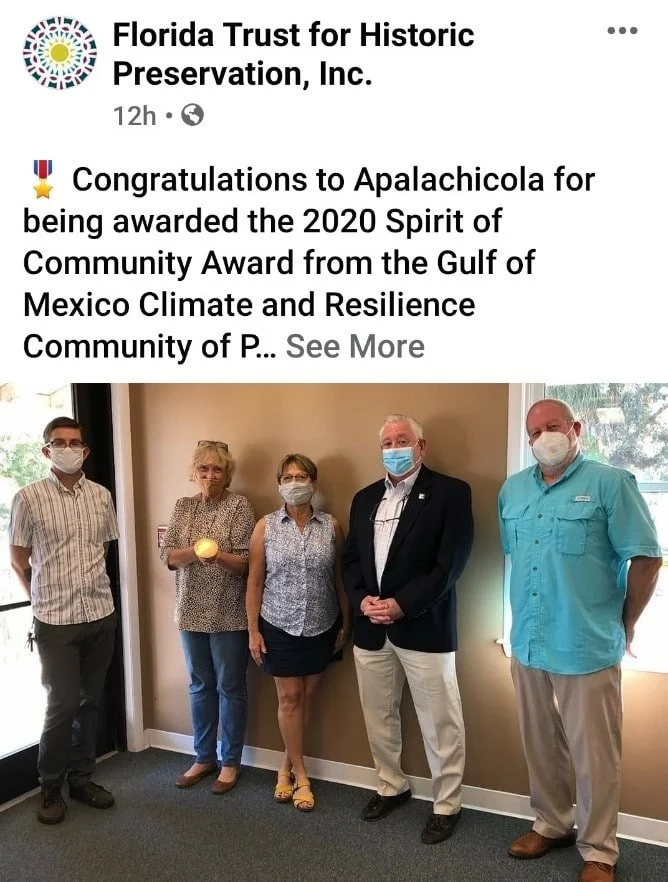
Our popular Sci-Café Series went virtual this year too. We held five virtual Sci-Cafes: Aquaculture in Apalachicola Bay, Apalachicola Bay System Initiative, MK Ranch Restoration, O.Y.S.T.E.R and Oyster Corps, and the Apalachicola Riverkeeper Apalachicola Bay Slough Restoration. One hundred and eighty people attended the five, hour-long talks which were recorded and can be viewed at https://www.apalachicolareserve.com/previous-events/#Sci-Cafe’s
The Reserve held its first research symposium February 18-19. The two-day event was very successful, enabling the Reserve to collaborate with colleagues, share information, and build future partnerships. CTP facilitated and produced the event, a two-day symposium that featured thirty-six speakers on topics ranging from oyster restoration and sea level rise to fishery management. We had a total of 155 unique participants the two days.
Collaborations
CTP also led a collaboration with the Franklin County Master Gardener Program, Franklin County libraries, and the Apalachicola Library to create a Pollinator Seed Library. The program was created in the fall to engage residents in an environmentally friendly activity they could do during the lockdown. The program was very popular, and we distributed hundreds of seed packets. We also held two socially distanced educational kayak trips in collaboration with Paddle the Gulf, one of which explored ecosystems and cultural history of the western end Apalachicola Bay in the fall. The other trip was held on Whisky George Creek in the spring.
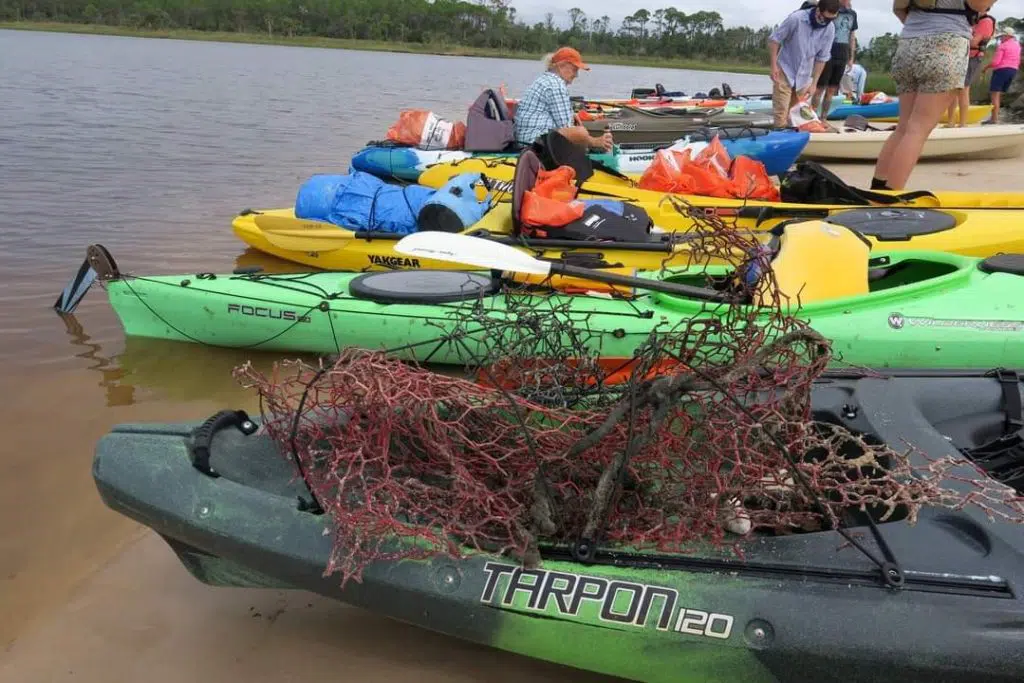
CTP helped to bring together the Reserve, Conservation Corps of the Forgotten Coast and five area restaurants to form the Oyster Corps and start the O.Y.S.T.E.R. (Offer Your Shell to Enhance Restoration) program to recycle oyster shells from local restaurants which currently end up in the landfill. The recycled shell will be used in shoreline stabilization and to help replant wild growing oysters in the Bay once they have been seeded with oyster spat from the new FSU Marine Lab.
CTP continues to work with the Panhandle Estuarine Restoration Team (PERT), a community of practice designed to share techniques, best management practices, and lessons learned among restoration practitioners. The group formed to help increase the use of living shorelines in the panhandle. We held the third annual meeting virtually in March and produced three webinars relevant to restoration practitioners: Living Shoreline Projects in Choctawhatchee Bay; Resilience of Living Shorelines in Pensacola During Hurricane Sally; and Funding for Living Shorelines.
Finally, CTP worked with the Franklin County Tourist Development Council staff to produce an article for their 2021 summer newsletter focused on endangered nesting sea turtles and leave-no-trace practices such as removing beach gear, filling holes, turning off lights and using proper lighting devices for night beach walking. We also produced a radio show and a video to highlight these good practices to help sea turtles during the nesting season.
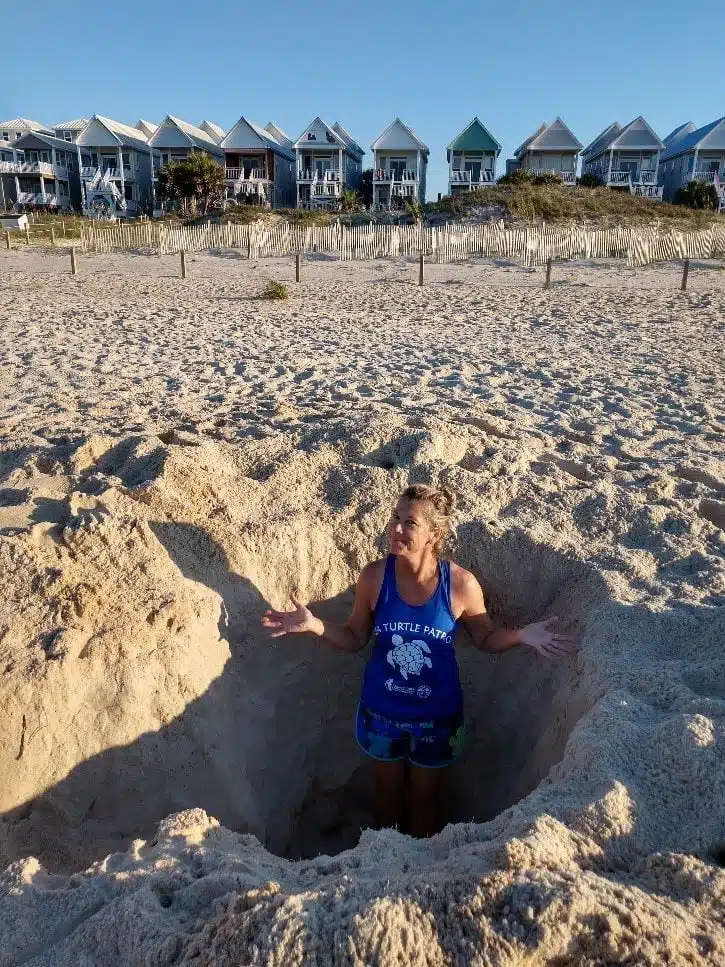
Performance Measures
For formal programs participants fill out a two-page evaluation after each course. These evaluations are analyzed to gauge the effectiveness of our programs and are submitted to the NOAA Coastal Training Program Performance Database. Participants are also asked to tell us what future trainings they would like to see offered.
Getting the word Out
Coastal Training Program and Communications staff use a variety of methods to engage potential and past participants. We email targeted audiences, post workshops to Eventbrite, social media, and on web-based calendars including ApalachicolaReserve.com, area community calendars with the chambers of commerce, the Franklin County Tourist Development Council, and living shorelines list serve. Calendar announcements on upcoming programs are also sent to the local newspapers and radio station, chambers of commerce, and shared on the Friends of the Reserve social media sites.
Engagement with National, Regional and Local Partners
CTP staff attended the National Estuarine Research Reserve annual conference virtually. We also collaborated with the two other Florida Reserves at GTM and Rookery, on a quarterly basis. The CTP coordinator serves on the national Digital Coast Partnership Community Rating System (CRS), a committee addressing flood risk reduction, ecosystem conservation, and climate change resilience in coastal communities through the National Flood Insurance Program’s (NFIP) CRS program.
